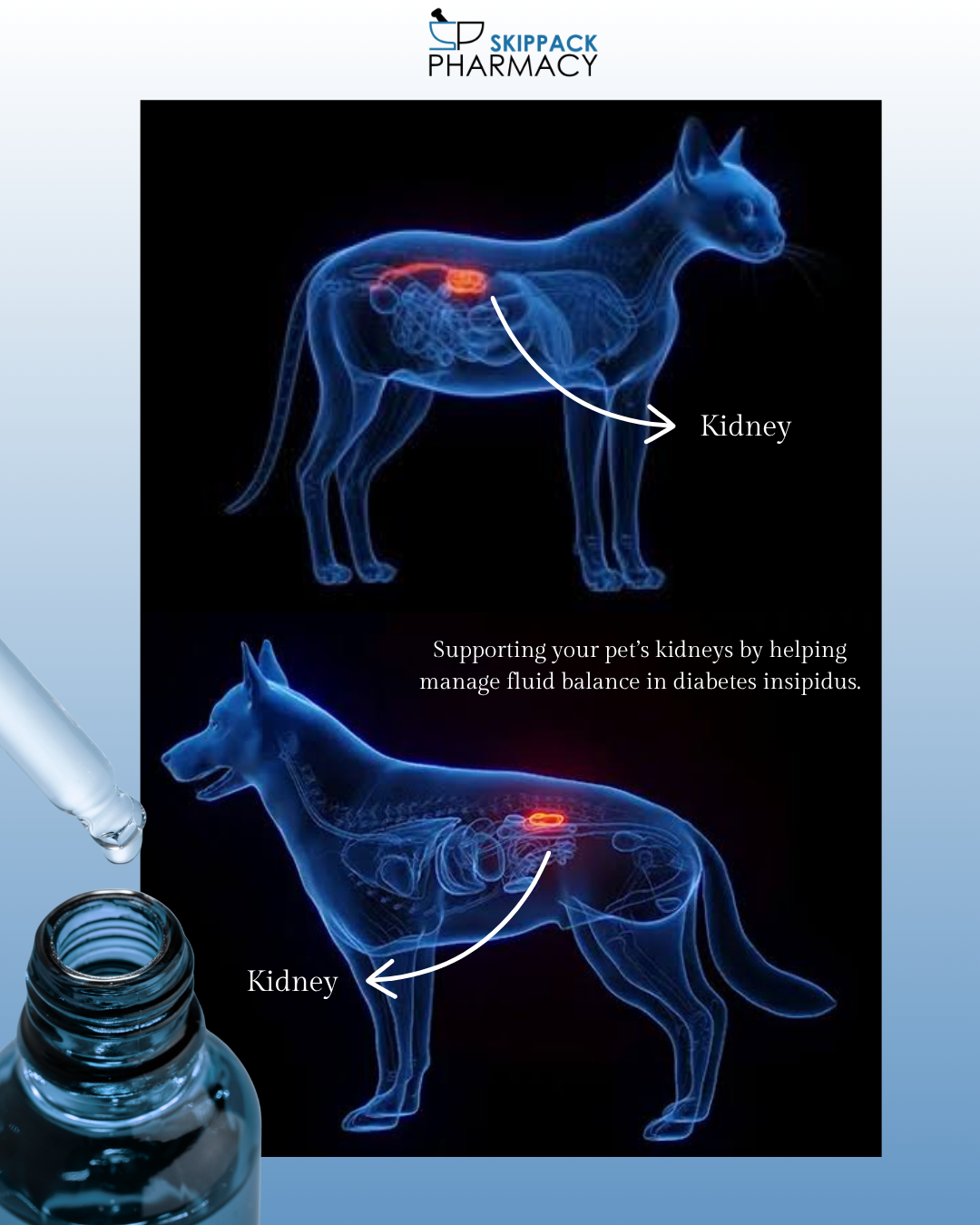
- Pet/Vet
-
by Skippack Pharmacy
A Unique Approach to Diabetes Insipidus in Pets
When our furry companions begin to show signs of excessive thirst and urination, it can be concerning and disruptive to their quality of life. One possible cause behind these symptoms is diabetes insipidus (DI)—a rare but serious condition that affects the body’s ability to conserve water. Unlike diabetes mellitus, diabetes insipidus is not related to blood sugar regulation. Instead, it results from a deficiency or resistance to antidiuretic hormone (ADH), also known as vasopressin. This hormone helps the kidneys concentrate urine and retain water. Desmopressin is often the treatment of choice for pets diagnosed with this, and is a very effective method for treating pets.
What Is Desmopressin?
Desmopressin acetate is a synthetic analogue of vasopressin. It mimics the natural hormone’s effects by acting on the kidneys to decrease urine output and increase water reabsorption. In veterinary medicine, desmopressin is used primarily to manage CDI in dogs and cats. It’s important to note that desmopressin is not effective for nephrogenic diabetes insipidus, where the kidneys are unresponsive to ADH.
Why Use Eye Drops?
At first glance, administering a hormone through the eyes may seem unusual. However, desmopressin eye drops are an established and efficient alternative to other administration routes. When given as an eye drop, desmopressin is absorbed through the conjunctival mucosa—the moist tissue that lines the eyelids and covers part of the eye. This route provides a non-invasive and relatively stress-free method of delivering medication, especially for owners who struggle with injections or when the nasal spray formulation is hard to obtain or administer in pets. Veterinarians typically instruct pet owners to apply one or two drops in the eye once or twice daily, depending on the animal’s response and water intake. The dose can be adjusted based on monitoring urine concentration and clinical signs.
Effectiveness and Monitoring
Desmopressin eye drops have proven to be effective in many cases of canine and feline Central Diabetes Insipidus (CDI). Owners often notice a dramatic improvement in symptoms, including reduced water intake and less frequent urination, within a few days of starting treatment. Because the response to desmopressin can vary, regular monitoring is essential. Veterinarians may recommend urine specific gravity testing, bloodwork, and tracking changes in thirst and urination at home. Adjusting the dose based on these observations ensures the pet receives optimal benefit without unnecessary medication.
Safety and Considerations
Desmopressin is generally well-tolerated in pets, especially when used at appropriate doses. However, if a pet receives too much, it may retain excess water, leading to dilutional hyponatremia—a potentially serious drop in blood sodium levels. This is why close veterinary supervision is crucial when initiating or adjusting therapy. Another consideration is cost. Desmopressin can be expensive, especially for large-breed dogs who may require higher doses. However, many pet owners find that the convenience and comfort of using eye drops are well worth the investment.
A Tailored Approach for Every Pet
Diabetes insipidus is rare, but when it occurs, timely diagnosis and treatment are key to maintaining a pet’s health and happiness. Desmopressin eye drops provide a unique and often effective solution, especially for families looking for an alternative to injections or nasal administration.
As always, treatment should be guided by a veterinarian with experience in managing endocrine disorders in pets. With the right approach, pets with CDI can live full, active lives—and desmopressin eye drops may be just the tool to make that possible.

